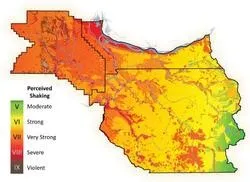DOGAMI: Study estimates Cascadia earthquake impacts for Portland region

Summary by city of estimated Cascadia earthquake impacts
Video recap of the study
Full text of the study
The study estimates Cascadia earthquake impacts that include as many as 27,000 injuries ranging from minor to fatal, 85,000 people needing shelter, and $37 billion in building damages.
“Understanding the potential impacts of a Cascadia earthquake helps our region plan and prepare for those impacts,” says Denise Barrett, manager of the Regional Disaster Preparedness Organization (RDPO), which partnered with DOGAMI on the study. “While much is being done around our five-county region to prepare government, business, non-profits, and communities for earthquakes, as well as other disasters, the study shows us we need to keep working together to reduce these impacts and become more resilient.”
Using updated building and population data, current earthquake science, and the latest mapping and modelling techniques greatly improved understanding of potential impacts, says DOGAMI’s John Bauer, the study’s lead investigator. Much of the region was relying on estimates that were 20 years old.
The need to better understand Cascadia earthquake impacts was highlighted in the Oregon Resilience Plan, says Jay Raskin, chairperson of the Oregon Seismic Safety Policy Advisory Council. OSSPAC is currently examining the state’s needs for mass care and shelter after a Cascadia earthquake – just one of many efforts the new estimates are essential to.
“Accurate estimates of injuries and people in need of shelter helps us plan to care for injured people, and to meet the needs of people whose homes won’t be safe to live in,” Raskin says.
The estimates also provide perspective on how important preparedness actions are for families and neighborhoods. The 27,000 estimated injuries represent approximately 2 percent of the three-county population. Most of those – about 20,000 – will be minor injuries, Bauer says. Being prepared to care for our families and each other in the days and weeks following a Cascadia earthquake is key.
“A Cascadia earthquake will happen,” Bauer says. “How well we prepare will make all the difference in how well we bounce back.”
DOGAMI and RDPO are beginning phase two of the study, which will examine earthquake impacts for Clark and Columbia counties and is anticipated to be complete in 2019. Studies were funded with a grant from the Urban Areas Security Initiative program through the RDPO.
Visit www.OregonGeology.org for a summary of estimated impacts by city, to look up expected shaking by address, or to download the full study with maps and data. [Note: these sources do not predict impacts to a specific building or home.]
